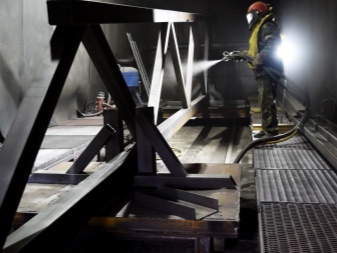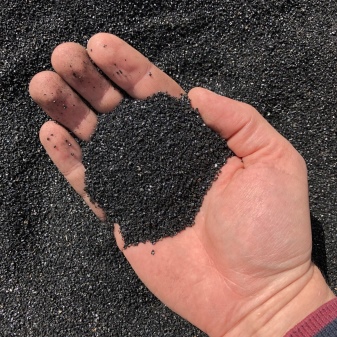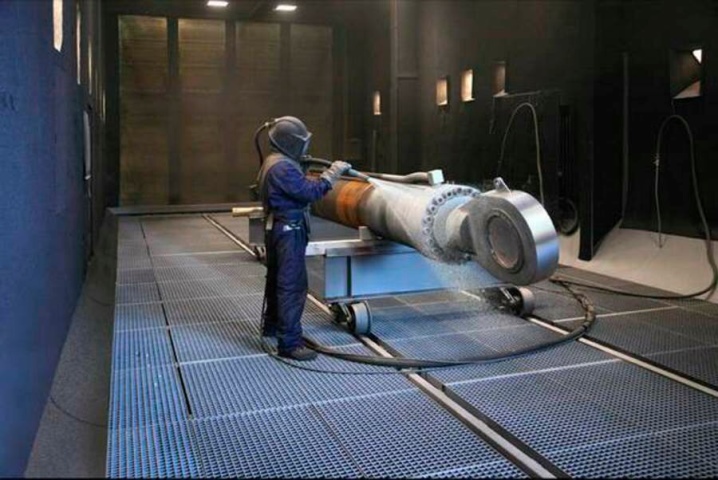Sandblasting metal

Manual multistage preparation of surfaces of metal products and structures for the application of various types of coatings on an industrial scale has long sunk into oblivion. Now there is a highly efficient technology for this in the form of sandblasting equipment. Let's consider what is the peculiarity of this technology, what is its functionality, what types it is subdivided into, what is included in the main equipment.


Features and purpose
Sandblasting of metal is the process of cleaning the surfaces of metal structures and other metal products from traces of corrosion, carbon deposits, old coatings (for example, varnishes, paints), scale after welding or cutting, foreign deposits by exposing them to a mixture of air with particles of abrasive materials supplied through high pressure nozzle to the metalworking site. As a result, there is a separation or complete erasure of all excess from the surface of the metal product being cleaned.
In addition, when abrasive particles hit the surface, they erase not only foreign substances from it, but also a small surface part of the metal itself, from which the structure being processed is made. After a well-done work with the help of sandblasting equipment, only pure metal remains on the surface of the metal product.
However, it should be noted that fat deposits, unfortunately, cannot be removed by sandblasting, as they penetrate too deeply into the metal. After the surface cleaning process with a sandblaster, oil stains should be treated with appropriate solvents before subsequent coating, which will degrease such areas.


The scope of sandblasting equipment is quite wide:
- factory processing of metal products and structures before applying paint and varnish coatings to finished products;
- during repair work on the main equipment of thermal power plants (for cleaning pipes of condensing and boiler plants, the inner surface of all kinds of vessels and pipelines, turbine blades);
- in metallurgical production;
- at aircraft factories in the manufacture of aluminum parts;
- in shipbuilding;
- in the production of mirrors and glass with a complex texture;
- in construction;
- at car service stations and in workshops where bodywork and straightening works are performed;
- in engraving workshops;
- in the manufacture of metal-ceramic prostheses;
- at enterprises for electroplating;
- after sandblasting, it is possible to troubleshoot metal structures, the operation of which must be carried out in accordance with GOST standards.


At home, such equipment is still rarely used - mainly by the owners of private houses and large household plots with outbuildings. It is necessary when cleaning existing metal surfaces before painting or applying protective agents.

Species overview
In general, there are 3 types of abrasive cleaning of metal surfaces, which have certain estimated boundaries between themselves: light, medium and deep. Consider a brief description of each species.


Light
An easy type of metal cleaning includes the removal of visible dirt, rust, as well as peeling old paint and scale. On examination, the surface appears to be fairly clean. There should be no contamination. Rust traces may be present. For this type of cleaning, mainly sand or plastic shot is used at a mixture pressure of not more than 4 kgf / cm2. Processing is carried out in one pass. This method is comparable to manual cleaning with a metal brush.


Average
With medium cleaning, a more thorough treatment of the metal surface is achieved by increasing the pressure of the air-abrasive mixture (up to 8 kgf / cm2). The average type of processing can be considered as such if on the metal surface after the passage of the sandblasting nozzle traces of corrosion remain only about 10% of the entire area. Slight dross may be present.


Deep
After deep cleaning, there should be no dirt, scale or rust. Basically, the metal surface should be perfectly clean and even, almost whitewashed. Here the pressure of the mixture of air and abrasive material reaches 12 kgf / cm2. The consumption of quartz sand with this method increases significantly.
According to the use of the working material in the mixture, two main types of cleaning are distinguished:
- air-abrasive;
- hydrosandblasting.


The first uses compressed air mixed with various abrasive materials (not only sand). In the second, the working component is water under pressure, into which sand particles (most often), glass beads and finely chopped plastic are mixed.
Hydro-sandblasting is characterized by a softer effect and a more thorough cleaning of the surface. Often, even oily contaminants can be washed out in this way.

Cleaning degrees
Using the method of abrasive cleaning, it is possible to achieve high-quality processing of metal structures not only before painting them, but also before applying coatings of a different nature, which are used in the installation or repair of such critical structures as supporting and other bearing elements of bridges, overpasses, overpasses and others.
The need to use sandblasting preliminary cleaning is regulated by GOST 9.402-2004, which specifies the requirements for the degree of preparation of metal surfaces for subsequent painting and application of protective compounds.
Experts distinguish between 3 main degrees of cleaning of metal structures, assessed by a visual method. Let's list them.
- Easy cleaning (Sa1). Visually, there should be no visible dirt and swollen rust spots. There are no places with a mirror-like metal effect.
- Thorough cleaning (Sa2). The remaining scale or rust spots should not lag behind when mechanically exposed to them. There is no contamination in any form. Local luster of the metal.
- The visual purity of the metal (Sa3). Complete cleanliness of the sandblasted surface, characterized by a metallic sheen.

What abrasives are used?
Previously, various types of natural sand were mainly used for sandblasting. Especially valuable were marine and desert, but now their use has been significantly reduced for reasons of safety when working with these raw materials.
Now there are other materials:
- vegetable (bones, husks, shells after appropriate processing);
- industrial (metal, non-metal production waste);
- artificial (for example, plastic shot).


Industrial metal materials include pellets and shot, which are produced from almost any metal. Of the non-metallic, glass grains can be noted, which, for example, are used when carrying out surface treatment to a thorough degree of cleaning with both air and water sandblasting devices.Among the materials obtained from metallurgical waste, the best known is copper slag, which is often used for the same purposes as glass.
For the highest cleanliness, hard abrasive materials such as fused alumina or steel grit are used. But the cost of such an abrasive is quite high.

Equipment
The set of light (non-industrial) sandblasting equipment based on air (water) includes:
- a compressor (pump) that creates the air (water) pressure required for work;
- a tank in which a working mixture of air (water) with an abrasive material is prepared;
- a nozzle made of high-strength material;
- connecting hoses with fasteners (clamps, adapters);
- control panel for the supply of working components and abrasive.


On an industrial scale, such work is carried out using more serious machines and apparatus, even a machine for preparing an abrasive can be used. And there are special chambers for metal cleaning.

Rules and technology
It remains only to learn some of the nuances of the cleaning technology and remember the rules for working with sandblasting equipment.
First of all, we will touch on the safety rules for self-sandblasting:
- at the place of production of metal cleaning, except for the direct participants in the process, there should be no people;
- before starting work, check the equipment for serviceability, hoses for integrity and tightness in the connections;
- workers must have a special suit, gloves, respirator and goggles;
- the respiratory organs when working with sand must be reliably protected, since dust from sand crushing can lead to serious illnesses;
- before filling the sand into the hopper, it must be sieved to avoid clogging of the nozzle;
- adjust the gun first to the lowest feed, and eventually add it to the nominal efficiency;
- it is not recommended to reuse abrasive material when working with a mobile unit;
- when sandblasting near walls, other building elements or any devices, it is necessary to protect them with screens made of metal sheets.


It is best to use dust-free equipment at home, which in terms of safety is close to the hydraulic counterpart. Its technology is no different from conventional air sandblasting, only the waste material is sucked into a special chamber, in which it is cleaned, preparing for reuse. Such a device can significantly reduce the consumption of sand or other abrasive material, reducing the cost of the cleaning process. In addition, there will be noticeably less dust.
Such a technology for processing metal structures even allows people who do not have protective equipment to be near the place of work.
If the work is carried out with hydraulic equipment, then the adjustment of the amount of abrasive can be made during cleaning, starting from its smallest feed. The pressure of the working fluid must be kept within 2 kgf / cm2. So it is better to control the processing process and regulate the supply of components to the cleaning site.
Sandblasting discs in the video below.













The comment was sent successfully.